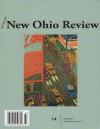New Ohio Review – Fall 2013
In the most recent issue of New Ohio Review (NOR), the editors feature a series of “Translation Cruxes,” inspiring meditations on the method by which we are able to access voices from afar. The trick, of course, is that the journal is full of translations—maybe not in the nature of the subjunctive, but rather in the way feelings are translated.
In the most recent issue of New Ohio Review (NOR), the editors feature a series of “Translation Cruxes,” inspiring meditations on the method by which we are able to access voices from afar. The trick, of course, is that the journal is full of translations—maybe not in the nature of the subjunctive, but rather in the way feelings are translated.
This issue featured fiction contest prizewinners Brian Trapp’s “The Best Man” and Bradley Bazzle’s “Crimes of the Video Age,” as selected by Stuart Dybek. Author of I Sailed with Magellan, Dybek is a master of what appears to be effortless storytelling. But “effortlessness” is just a ruse—under the joy of his craft is a thoughtful deliberation—and his choices in NOR were completely aligned with this approach.
Bazzle’s story is one of the finest I have ever read; it channels Bradbury to address serious social realities with a near Shakespearean scope. The story is very brisk, with humor and terror managed expertly. On one level, it tells the story of two clowns, a half-naked sunbather, and a world where every movement is captured on film. On another level, it is about disguise and identity and about the impact of technology on evidence and perceptions of reality.
Trapp’s “The Best Man” presents a startlingly original premise: two American expats to China are hired to stand in at a wedding to lend the bride and groom a kind of prestige. While the story is funny and bombastic at times, flowing with a kind of effervescent effortlessness, it is more than just a look at race and culture in the now with a nod to the future. Its execution is sincere, and the characters do not simply stand in for political commentary. In fact, the characters are so real that your heart will break for them. And so while the setting and the artistic value proposition are compelling and bravely negotiated, this is a story that can and does happen anywhere.
Brave experiments exist in the poetry of NOR as well. Take three poems by Michael Casey: each is a perfect translation of experience to a larger reality, which is perhaps the effect of the very best poetry, but Casey expresses sublimation in a vital and new way. For example, in “for Claude Monet” Casey crosses culture and time with an examination of perspective anchoring very different worlds. The legwork is elegant; there is no pretense to deter the reader from her own literary experience:
I mean the excitement level
was just about in negative numbers
as my sister’s basketball team
lost its seventh straight
. . . . . . . . . . . . . . . . . . .
no sense of perspective
in art too you have to see
my sister’s painting
of the flour mill with the water wheel
Casey’s three poems carry this style throughout. They are conversational without being confessional, brave and straightforward without any hint of cliché. What drew me to Casey’s work was that he tackled tough subjects for poets—the world of the office relationships, for example. It made me think of S.Y. Agnon simply in terms of the economy of great ideas in such disciplined language.
Tam Lin Neville’s memoir “The Skirts and Blouses are Hatched” is finely designed and orchestrated with just enough of the key elements to carry you forward: her family, herself, ultimate loss, the snow, the cycle of life. I admire her restraint and that the story—to its own tempo—still touches you innately, quietly. I thought of this driving feeling when reading Eleanor Stanford’s essay “Seven to One” when she says with perfect emotional pitch: “She hums a song whose only word is the untranslatable sodadi: longing for something you can’t have, a longing so strong that it eclipses the object of desire.”
The journal’s section on what is translatable is rife with ideas—translating sound (Patty Crane), translating Choctaw poems (Marcia Haag), translating surrealism (Mark Polizzotti), translating “the just name” (Robert Chandler), and translating “Stone upon Stone” (Bill Johnston). The essays are compact and economical, fine winter reading that teaches you about the building blocks of language and the weave of meaning buried in every vowel and inflection. And, more broadly, it is a love of language in every line—the careful choices NOR writers make—that sets New Ohio Review apart as an essential voice for these times.
[www.ohio.edu/nor]





